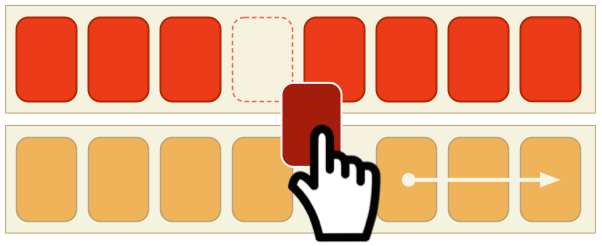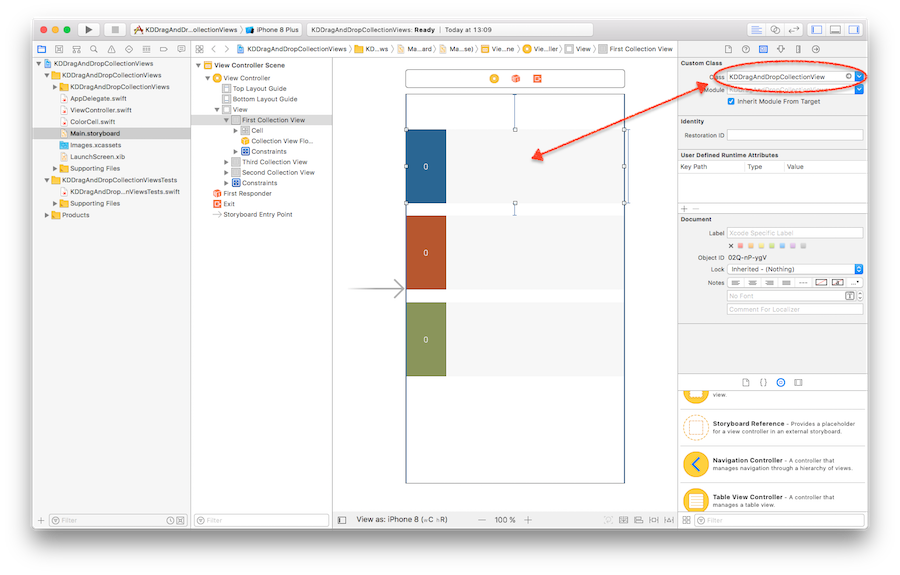KDDragAndDropCollectionView alternatives and similar libraries
Based on the "Table View / Collection View" category.
Alternatively, view Drag and Drop UICollectionView alternatives based on common mentions on social networks and blogs.
-
SwipeCellKit
Swipeable UITableViewCell/UICollectionViewCell based on the stock Mail.app, implemented in Swift. -
MCSwipeTableViewCell
DISCONTINUED. 👆 Convenient UITableViewCell subclass that implements a swippable content to trigger actions (similar to the Mailbox app). -
HGPlaceholders
Nice library to show placeholders and Empty States for any UITableView/UICollectionView in your project -
ReverseExtension
A UITableView extension that enables cell insertion from the bottom of a table view. -
Bohr
DISCONTINUED. Bohr allows you to set up a settings screen for your app with three principles in mind: ease, customization and extensibility. -
CenteredCollectionView
A lightweight UICollectionViewLayout that 'pages' and centers its cells 🎡 written in Swift -
CascadingTableDelegate
A no-nonsense way to write cleaner UITableViewDelegate and UITableViewDataSource in Swift. -
GLTableCollectionView
Netflix and App Store like UITableView with UICollectionView, written in pure Swift 4.2 -
ListPlaceholder
ListPlaceholder is a swift library allows you to easily add facebook style animated loading placeholder to your tableviews or collection views. -
DataSources
💾 🔜📱 Type-safe data-driven CollectionView, TableView Framework. (We can also use ASCollectionNode) -
DTTableViewManager
Protocol-oriented UITableView management, powered by generics and associated types. -
TLIndexPathTools
TLIndexPathTools is a small set of classes that can greatly simplify your table and collection views. -
CollapsibleTableSectionViewController
:tada: Swift library to support collapsible sections in a table view. -
RHPreviewCell
I envied so much Spotify iOS app this great playlist preview cell 😍, I decided to create my own one 🌶. Now you can give your users ability to quick check "what content is hidden under your UITableViewCell". Great think is that this Library not requires 3D Touch support from user device💥. -
SquareMosaicLayout
An extandable mosaic UICollectionViewLayout with a focus on extremely flexible customizations :large_orange_diamond: -
HoverConversion
DISCONTINUED. HoverConversion realized vertical paging with UITableView. UIViewController will be paging when reaching top or bottom of UITableView contentOffset. -
GenericDataSource
A generic small reusable components for data source implementation for UITableView/UICollectionView in Swift. -
PJFDataSource
PJFDataSource is a small library that provides a simple, clean architecture for your app to manage its data sources while providing a consistent user interface for common content states (i.e. loading, loaded, empty, and error). -
AZCollectionViewController
Easy way to integrate pagination with dummy views in CollectionView, make Instagram "Discover" within minutes. -
ios-dragable-table-cells
DISCONTINUED. Objective-C library for drag-n-drop of UITableViewCells in a navigation hierarchy of view controllers.
WorkOS - The modern identity platform for B2B SaaS

* Code Quality Rankings and insights are calculated and provided by Lumnify.
They vary from L1 to L5 with "L5" being the highest.
Do you think we are missing an alternative of KDDragAndDropCollectionView or a related project?
README
Drag and Drop Collection Views
Written for Swift 4.0, it is an implementation of Dragging and Dropping data across multiple UICollectionViews.

Try it on Appetize.io!
Requirements
- iOS 8.0+
- XCode 9.0+
- Swift 4.0 +
Installation
Cocoa Pods
pod 'KDDragAndDropCollectionViews', '~> 1.5.2'
Manual
Add the files in Classes/ to your project.
Quick Guide
Make the UICollectionView of interest a KDDragAndDropCollectionView

Then set a class as dataSource implementing the KDDragAndDropCollectionViewDataSource protocol.
class ViewController: UIViewController, KDDragAndDropCollectionViewDataSource {
@IBOutlet weak var firstCollectionView: KDDragAndDropCollectionView!
@IBOutlet weak var secondCollectionView: KDDragAndDropCollectionView!
@IBOutlet weak var thirdCollectionView: KDDragAndDropCollectionView!
var data : [[DataItem]] = [[DataItem]]() // just for this example
var dragAndDropManager : KDDragAndDropManager?
override func viewDidLoad() {
let all = [firstCollectionView, secondCollectionView, thirdCollectionView]
self.dragAndDropManager = KDDragAndDropManager(canvas: self.view, collectionViews: all)
}
}
The only responsibility of the user code is to manage the data that the collection view cells are representing. The data source of the collection views must implement the KDDragAndDropCollectionViewDataSource protocol.
In the example we have 3 UICollectionViews distinguishable by their tags (bad practice, I know... but it's only an example ;-) and a data array holding 3 arrays respectively. In a case like this, an implementation of the above could be:
func collectionView(collectionView: UICollectionView, dataItemForIndexPath indexPath: NSIndexPath) -> AnyObject {
return data[collectionView.tag][indexPath.item]
}
func collectionView(collectionView: UICollectionView, insertDataItem dataItem : AnyObject, atIndexPath indexPath: NSIndexPath) -> Void {
if let di = dataItem as? DataItem {
data[collectionView.tag].insert(di, atIndex: indexPath.item)
}
}
func collectionView(collectionView: UICollectionView, deleteDataItemAtIndexPath indexPath : NSIndexPath) -> Void {
data[collectionView.tag].removeAtIndex(indexPath.item)
}
func collectionView(collectionView: UICollectionView, moveDataItemFromIndexPath from: NSIndexPath, toIndexPath to : NSIndexPath) -> Void {
let fromDataItem: DataItem = data[collectionView.tag][from.item]
data[collectionView.tag].removeAtIndex(from.item)
data[collectionView.tag].insert(fromDataItem, atIndex: to.item)
}
func collectionView(_ collectionView: UICollectionView, indexPathForDataItem dataItem: AnyObject) -> IndexPath? {
guard let candidate = dataItem as? DataItem else { return nil }
for (i,item) in data[collectionView.tag].enumerated() {
if candidate != item { continue }
return IndexPath(item: i, section: 0)
}
return nil
}
Advanced Use
Prevent specific Items from being Dragged and/or Dropped
For a finer tuning on what items are draggable and which ones are not we can implement the following function from the KDDragAndDropCollectionViewDataSource protocol
func collectionView(_ collectionView: UICollectionView, cellIsDraggableAtIndexPath indexPath: IndexPath) -> Bool {
return indexPath.row % 2 == 0
}
Data Items and Equatable
In the example code included in this project, I have created a DataItem class to represent the data displayed by the collection view.
class DataItem : Equatable {
var indexes: String
var colour: UIColor
init(indexes: String, colour: UIColor = UIColor.clear) {
self.indexes = indexes
self.colour = colour
}
static func ==(lhs: DataItem, rhs: DataItem) -> Bool {
return lhs.indexes == rhs.indexes && lhs.colour == rhs.colour
}
}
In the course of development you will be making your own types that must comform to the Equatable protocol as above. Each data item must be uniquely idenfyiable so be careful when creating cells that can have duplicate display values as for example a "Scrabble" type game where the same letter appears more than once. In cases like these, a simple identifier will do to implement the equality.
*Note that all licence references and agreements mentioned in the KDDragAndDropCollectionView README section above
are relevant to that project's source code only.





